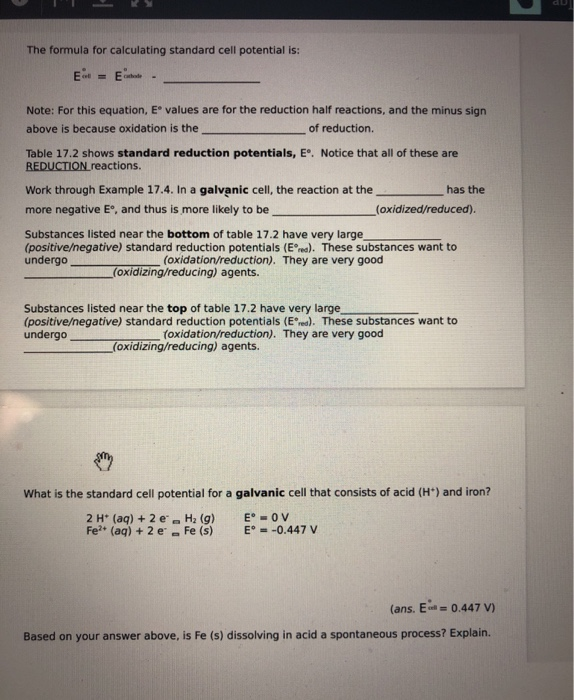Answered step by step
Verified Expert Solution
Question
1 Approved Answer
The formula for calculating standard cell potential is: Et = E . Note: For this equation, E values are for the reduction half reactions,

The formula for calculating standard cell potential is: Et = E . Note: For this equation, E values are for the reduction half reactions, and the minus sign above is because oxidation is the of reduction. Table 17.2 shows standard reduction potentials, E. Notice that all of these are REDUCTION reactions. Work through Example 17.4. In a galvanic cell, the reaction at the more negative E, and thus is more likely to be has the (oxidized/reduced). Substances listed near the bottom of table 17.2 have very large, (positive/negative) standard reduction potentials (Ered). These substances want to undergo (oxidation/reduction). They are very good (oxidizing/reducing) agents. Substances listed near the top of table 17.2 have very large (positive/negative) standard reduction potentials (Ered). These substances want to undergo (oxidation/reduction). They are very good (oxidizing/reducing) agents. a What is the standard cell potential for a galvanic cell that consists of acid (H*) and iron? E = OV 2 H+ (aq) + 2 e Fe+ (aq) + 2 e H (g) Fe (s) E = -0.447 V (ans. E= 0.447 V) Based on your answer above, is Fe (s) dissolving in acid a spontaneous process? Explain.
Step by Step Solution
★★★★★
3.38 Rating (145 Votes )
There are 3 Steps involved in it
Step: 1
In an electrochemical cell the half cell with higher reduction potential always acts as a cathode undergoes reduction and oxidizes the reductant The h...
Get Instant Access to Expert-Tailored Solutions
See step-by-step solutions with expert insights and AI powered tools for academic success
Step: 2

Step: 3

Ace Your Homework with AI
Get the answers you need in no time with our AI-driven, step-by-step assistance
Get Started


